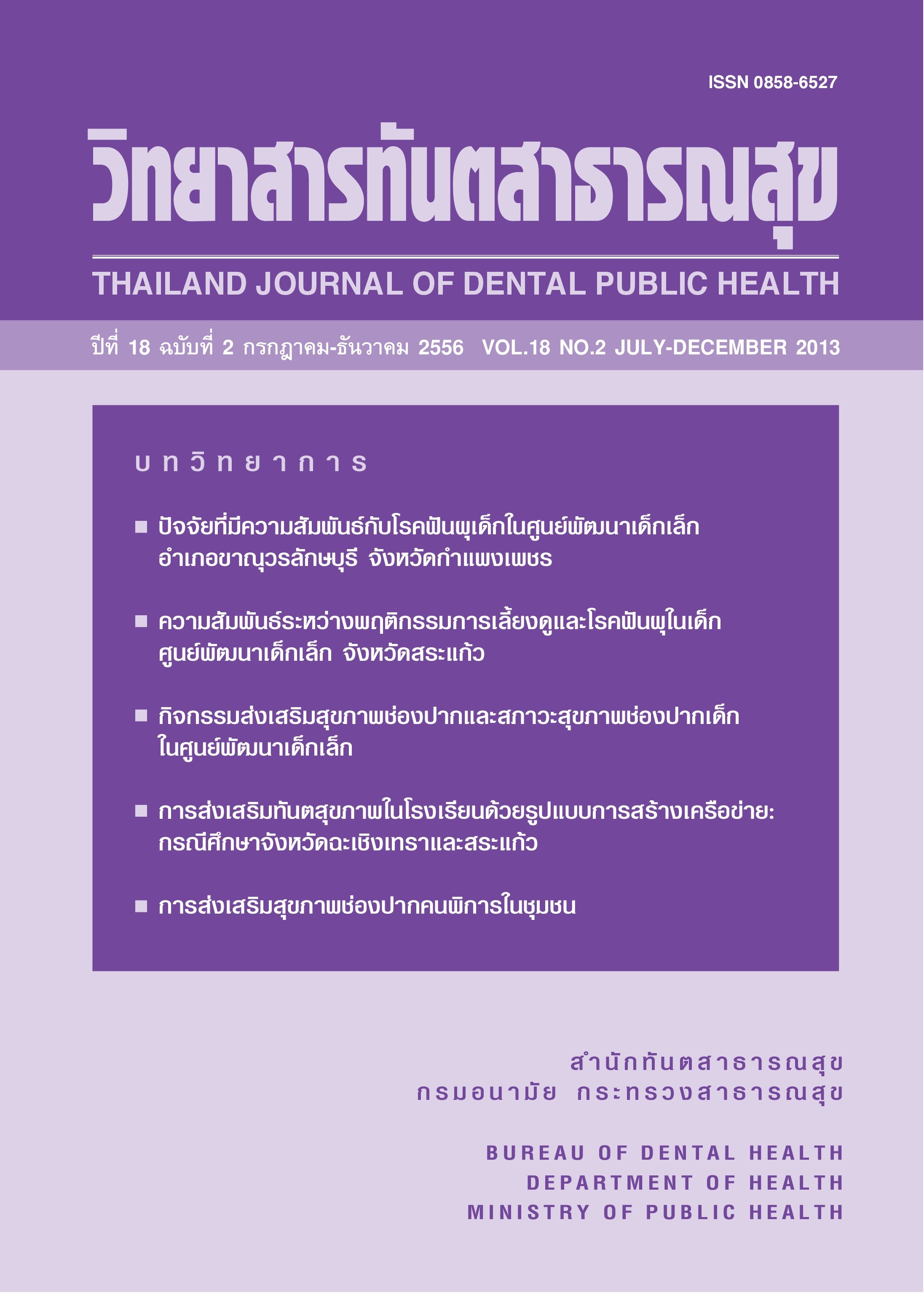Association between child care behaviors and early childhood caries in Sa kaeo province
Main Article Content
Abstract
The purpose of this study was to assess the association between child care behaviors and early childhood caries in children 2-5 years old residing in Sa Kaeo province, Thailand, during August to December, 2012. This cross-sectional analytic study included 431 children, 194 boys (45.01%) and 237 girls (54.98%) whose parents volunteered to take part in the study. Data on both the children and the parents were collected using a questionnaire as well as an oral health examination. Results were analyzed by means of descriptive, bivariate, and multivariable logistic regression analyses. Findings from descriptive statistics showed that 338 out of 431 children (78.42 %) had early childhood caries (ECC). The final multivariable logistic regression model showed that early childhood caries (ECC) was associated significantly with parents’ oral health knowledge [AOR= 2.361; 95%CI=1.012-5.506], parents who did not check up their children’s teeth [AOR=3.177; 95%CI=1.768-5.709], children who had breastfeeding before wean [AOR=2.471; 95%CI=1.425-4.285], age children started sweet beverages [AOR=0.966; 95%CI=0.938-0.993] parents’ DMFT [AOR=1.086; 95%CI=1.029-1.147]. The findings confirm the importance of child care behaviors relating to early childhood caries. To reduce limitation of this cross-sectional study, a longitudinal study should be conducted further in order to clearly explain the association between child care behaviors and early childhood caries so that the results will be better used for planning dental health promotion programs for young children.
Downloads
Article Details
References
2. สิทธิชัย ขุนทองแก้ว. วิทยาการโรคฟันผุ พิมพ์ครั้งที่ 2 กรุงเทพมหานคร บริษัทไอกรุ๊ปเพรสจำกัด 2552
3. นุสรา ภูมาศ. รูปแบบการผุของฟันน้ำนมในเด็ก 3 และ 6 ปี : จังหวัดมหาสารคาม. วิทยานิพนธ์วิทยาศาสตร์มหาบัณฑิต สาขาทันตสาธารณสุข คณะทันตแพทยศาสตร์ มหาวิทยาลัยขอนแก่น. ประเทศไทย, 2539.
4. กรมอนามัย กองทันตสาธารณสุข รายงานผลการสำรวจสภาวะทันตสุขภาพแห่งชาติครั้งที่ 6 พ.ศ.2549-2550,โรงพิมพ์สำนักกิจการองค์การทหารผ่านศึก; 2551.
5. จีรศักดิ์ ทิพย์สุนทรชัย. การศึกษาเปรียบเทียบอัตราการเกิดฟันผุเด็กที่เข้าร่วมโครงการและไม่เข้าร่วมโครงการแม่ลูกฟันดี 102 ปี สมเด็จย่า จังหวัดบุรีรัมย์. ว ทันต 2551; 13: 16-24.
6. กนกพร โพธิ์หอม. ความชุกความรุนแรงและรูปแบบการผุของฟันน้ำนมในเด็กอายุ 3 ปี อ.เมือง จ.นครสวรรค์. ว ทันต 2551; 13: 150-9.
7. สำนักทันตสาธารณสุข. รายงานระบบเฝ้าระวังทันตสาธารณสุข. http://phdb.moph.go.th/hssd1/umd/HSS_DENTAL/report/report_dental.php. สืบค้นวันที่ 20 เมษายน 2555.
8. อรุณ จิรวัฒน์กุล. สถิติทางวิทยาศาสตร์สุขภาพเพื่อการวิจัย. กรุงเทพฯ: วิทยพัฒน์; 2552.
9. ศศิธร ตาลอำไพ. ประสิทธิผลของฟลูออไรด์วาร์นิชในการป้องกันฟันผุ เปรียบเทียบระหว่างการทาทุก 3 เดือน และ6 เดือนในเด็ก 8-22 เดือน [วิทยานิพนธ์]. ขอนแก่น: มหาวิทยาลัยขอนแก่น; 2550. ประเทศไทย.
10. WHO. Dental status/Caries Recording Form . Available from: http://www.mah.se/CAPP/Methods-and-Indices/Assessment-Forms-for-Clinical-Investigations/Oral-Health-Assessment-Form1/ (cited 28 Feb 2012)
11. Kressin NR, Nunn ME, Singh H, Orner MB, Pbert L, Hayes C, et al. Pediatric clinicians can help reduce rates of early childhood caries: effects of a practice based intervention. Med Care 2009; 47 (11): 1121-8.
12. Chan SCL, Tsai JSJ, King NM. Feeding and oral hygiene habits of preschool children in Hong Kong and their caregivers’ dental knowledge and attitudes. Int J Paediatr Dent 2002; 12: 322-31.
13. วสิน เทียนกิ่งแก้ว. ปัจจัยที่มีผลต่อประสบการณ์ฟันผุของเด็กก่อนวัยเรียนในศูนย์ดูแลเด็กเล็ก อำเภออ่าวลึก จังหวัดกระบี่. วิทยานิพนธ์วิทยาศาสตร์มหาบัณฑิต สาขาทันตสาธารณสุข คณะทันตแพทยศาสตร์ มหาวิทยาลัยเชียงใหม่. 2539.
14. Caplan LS, Erwin K, Lense E, Hick J Jr. The potential role of breast-feeding and other factor in helping to reduce early childhood caries. J Public Health Dent 2008; 68 (4): 238-41.
15. Iida H, Auinger P, Billings RJ, Weitzman M. Association between infant breastfeeding and early childhood caries in the United States. Pediatrics 2007; 120 (4): e944-52.
16. Valaitis R, Hesch R, Passarelli C, Sheehan D, Sinton J. A systematic review of the relationship between breast feeding and early childhood caries. Canadian Journal of Public Health 2000; .91: 411–7.
17. Bowen WH, Pearson SK. 1993. Effect of milk on cariogenesis. Caries Res 27: 461-6.
18. Kashket S, DePaola DP. Cheese consumption and the development and progression of dental caries. Nutrition Reviews 2002; 60: 97-103.
19. Kawashita Y, Fukuda H, Kawasaki K, Kitamura M, Hayashida H, Furugen R, et al. Pediatrician recommended use of sports drinks and dental caries in 3-year old children. Community Dent Health 2011; 28: 29-33.
20. Berkowitz, RJ. Acquisition and transmission of mutans streptococci. J Calif Dent Assoc 2003; 31(2): 135-8.
21. Thitasomakul S, Piwat S, Thearmontree A, Chankanka O, Pithpornchaiyakul W, Madyusoh S. Risk for early childhood caries analyzed by negative binomiall models. J Dent Res 2009; 88 (2): 137-41.


